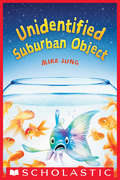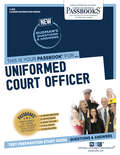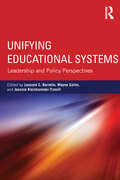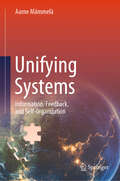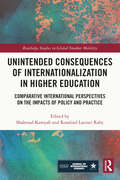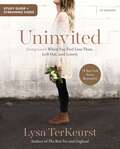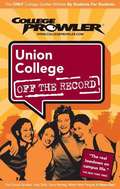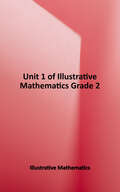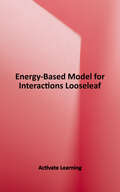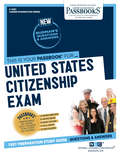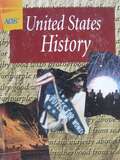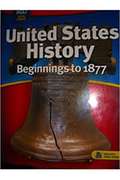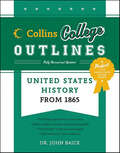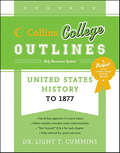- Table View
- List View
Unidentified Suburban Object (Arthur A Levine Novel Bks.)
by Mike JungComic and satirical, but also full of painful truths about being both a bright, sensitive middle schooler, and a so-called "model-minority" in a decidedly NOT-diverse townThe next person who compares Chloe Cho with famous violinist Abigail Yang is going to HEAR it. Chloe has just about had it with people not knowing the difference between someone who's Chinese, Japanese, or Korean. She's had it with people thinking that everything she does well -- getting good grades, winning first chair in the orchestra, et CETera -- are because she's ASIAN.Of course, her own parents don't want to have anything to DO with their Korean background. Any time Chloe asks them a question they change the subject. They seem perfectly happy to be the only Asian family in town. It's only when Chloe's with her best friend, Shelly, that she doesn't feel like a total alien. Then a new teacher comes to town: Ms. Lee. She's Korean American, and for the first time Chloe has a person to talk to who seems to understand completely. For Ms. Lee's class, Chloe finally gets to explore her family history. But what she unearths is light-years away from what she expected.
Uniformed Court Officer: Passbooks Study Guide (Career Examination Series)
by National Learning CorporationThe Uniformed Court Officer Passbook® prepares you for your test by allowing you to take practice exams in the subjects you need to study. It provides hundreds of questions and answers in the areas that will likely be covered on your upcoming exam, including but not limited to: Reasoning clearly and making sound decisions related to security in courtroom situations; Legal terminology, documents and forms; Evaluating information and evidence; Supervision; and more.
Unifying Educational Systems: Leadership and Policy Perspectives
by Wayne Sailor Leonard C. Burrello Jeannie Kleinhammer-TramillUnifying Educational Systems encourages leaders to move beyond the traditional forms and rituals of leadership for special education that are caught within traditional definitions of a continuum of services. Grounded in public policy debates, research on teaching and learning, and an emerging consensus throughout the leadership community that calls into question our current practices, chapters in this volume provide a discussion of the purpose, principles, and paradoxes extant in the implementation of current special education policy. Chapter authors discuss how students are currently served, the feasibility of re-conceptualizing special education leadership in the current policy context, and the challenges for the future. Ultimately, Unifying Educational Systems calls for a new policy framework to integrate special education within the larger instructional support system in schools, in order to support a social justice and inclusive practices agenda.
Unifying Systems: Information, Feedback, and Self-Organization
by Aarne MämmeläInterdisciplinary systems thinking is complementary but does not replace conventional disciplinary analytical thinking. The book is valuable for researchers, their advisors, and other thinkers interested in deep knowledge of science. Interdisciplinary systems thinking is valuable for three reasons: The goal of all science is a unified view of the world; we cannot solve the significant problems of our time without interdisciplinary collaboration; and general theories of systems and system archetypes support the solution to those problems. System archetypes are generic system models that have stood the test of time. As specialists within a discipline, we must be able to communicate between disciplines. Interdisciplinary generalists can offer us reliable visions and relevant research problems. The goal of interdisciplinary research is to find unified solutions to those problems. The book provides a lot of information from over a thousand sources in a structured manner to help the reader. The book includes a comprehensive chronology, vocabulary, and bibliography. The author has been a research professor in information engineering for over 25 years. During his career, he became interested in systems thinking, which is closely related to the philosophy and history of science.
Unintended Consequences of Internationalization in Higher Education: Comparative International Perspectives on the Impacts of Policy and Practice (Routledge Studies in Global Student Mobility)
by Rosalind Latiner Raby Shahrzad KamyabBy presenting case studies of internationalization in institutions of higher education around the world, this volume identifies unforeseen or unintended impacts within and across countries. With contributions from Africa, Asia, Europe, Latin America, Middle East, and North America the volume considers the nature and origin of positive and negative unintended consequences of internationalization policy and practice in national contexts, while also offering uniquely comparative insights. Chapters consider how internationalization is reflected in curricula, teaching, research, and mobility initiatives to highlight common pitfalls, as well as best practice for effective, sustainable, and equitable internationalization globally. Using a critical lens, the book explores how internationalization offers opportunities for learning, for entrepreneurial change, and for knowledge dissemination, and generates paradoxes and dilemmas in terms of political and ethical issues for individuals, communities, and the institutions themselves. Foregrounding the study of internalization in countries not typically studied, this book is a valuable resource for researchers and academics with an interest in internationalization, comparative and international education, and the sociology of education.
Uninvited Bible Study Guide plus Streaming Video: Living Loved When You Feel Less Than, Left Out, and Lonely
by Lysa TerKeurstDo you ever feel left out, lonely, less than loved? Most of us have. Many of us do now... Sometimes you simply need to be reminded how loved you really are—that every day, with every breath, you are loved with such precision that every hair, every molecule of you is known, counted, invited, and welcomed. This six-session video study guide (video streaming included) is that reminder. Best-selling author and speaker Lysa TerKeurst will walk you through the Holy Land in order to come closer to Jesus' words that will help you enter a place of healing and new perspective. You and your group are invited to:Explore the roots of rejection and learn practical ways to process your pain in a safe space.Dwell on the majestic declarations of God's love in the Bible.Discover a deep assurance of your adoption into Christ's family that leads to new life.Be a part of this biblical learning process of "living loved." Uninvited will remind you and your group that you are destined for a love that can never be diminished, tarnished, shaken, or taken—a love that does not reject or uninvite.This study guide has everything you need for a full Bible study experience, including:The study guide itself—with discussion and reflection questions, video notes, and a leader's guide.An individual access code to stream all six video sessions online (DVD also available separately).Sessions and video run times:Living Loved (25:30)Empty or Full? (15:30)The Yoke of God is Freedom (16:00)Set Apart (12:30)Remembering God&’s Presence (24:00)Lessons from the Olive (21:00)Bonus Session: Review and Celebration (no video) Watch on any device!Streaming video access code included. Access code subject to expiration after 12/31/2027. Code may be redeemed only by the recipient of this package. Code may not be transferred or sold separately from this package. Internet connection required. Void where prohibited, taxed, or restricted by law. Additional offer details inside.
Union College (College Prowler)
by Aaron Edelstein Lily GordonNo university affiliations. No half-truths. No out-of-touch authors who haven't been in school for decades. A class project turned company, College Prowler produces guidebooks that are written by actual college students and cover the things students really want to know. Unlike other guides that jam everything into a five-pound book and devote only two pages to each college, our single-school guidebooks give students only the schools they want and all the information they need. From academics and diversity to nightlife and sports, we let the students tell it how it is. In addition to editorial reviews and grades for 20 different topics, more than 80 percent of each guide is composed of actual student reviews of their school. Whether readers are looking for "Best and Worst" lists, "Did You Knows?" or traditions, College Prowler guides have it all. Our books are the only place for local slang, urban legends, and tips on the best places to find a date, study, or grab a bite to eat.
Unison Reading: Socially Inclusive Group Instruction for Equity and Achievement
by Cynthia MccallisterUnison Reading engages students as they read content aloud in small, diverse groups. Results include increased equity, social engagement, collaborative learning, and student achievement.
Unit 1 of Illustrative Mathematics Grade 2
by Illustrative MathematicsLearnZillion Illustrative Mathematics for grades K–5, an IM-certified program, offers the highest quality math curricula powered by a best-in-class integrated learning experience. The comprehensive, flexible solution equips teachers with easy-to-use lesson cards and teaching notes, digital interactives and assessments, and built-in differentiation. The instructional design engages students through collaborative math discourse, inclusive instructional routines, and digital tools that promote thinking and reasoning. LearnZillion IM supports all students on their college and career readiness journey — whether they are learning in a classroom, hybrid, or distance learning model. The LZ IM Print + Digital Bundle 5 years offers consumable print student workbooks (all volumes) and a student digital license for 5 years. The digital student license includes access to student workbook content, interactive lessons, videos, digital interactives, digital assessments, digital practice sets, and more!
Unit EM: Energy-based Model for Interactions
by Activate LearningUnit EM in NextGen PET focuses on an energy-based model for understanding object interactions. This model helps students visualize and quantify energy transfers and changes during various interactions, such as in electric circuits, by using G/R (Giving/Receiving) energy diagrams. The unit progresses from qualitative descriptions of energy flow to quantitative calculations, including energy efficiency and validating energy conservation.
United States Citizenship Exam: Passbooks Study Guide (Career Examination Series)
by National Learning CorporationThe United States Citizenship Exam Passbook® prepares you for your test by allowing you to take practice exams in the subjects you need to study. It provides hundreds of questions and answers in the areas that will likely be covered on your upcoming exam.
United States Citizenship Student Text (Living in the United States Series)
by Kristina M. SwannUNITED STATES CITIZENSHIP, a component of the Living in the United States series, is an abbreviated version of traditional basal programs, written on Reading Level 3.0 - 4.5. The low reading level; sophisticated page layout; and age-appropriate visuals make each Student Text and accompanying activities appealing to struggling readers. The standards-based programs are appropriate for on-level students, students with learning differences, and students and adults reading below grade level. STUDENT TEXT - The full-color, 48-page Student Text features six easy-to-read chapters. Students will be able to explain the freedoms and responsibilities of U.S. citizens. Specifically, students will learn about the cultural makeup of the United States; principles of democracy; rights guaranteed by the Constitution and the Bill of Rights, such as due process rights; laws and important figures of the civil rights movement; voter qualifications such as citizenship, residence, and age; and more.
United States Government: Democracy in Action, Guided Reading Activities
by McGraw-Hill StaffThe United States Government: Democracy in Action Guided Reading Activities provides activities for students who would benefit from a review of the material. By focusing on key information and concepts, Guided Reading Activities help students to understand and make appropriate connections among the ideas and facts they encounter in the student text.
United States Government: Democracy in Action, Reading Essentials & Study Guide
by Glencoe Mcgraw-HillStudent Workbook. The Reading Essentials and Study Guide is designed to help you use recognized reading strategies to improve your reading-for-information skills.
United States History
by John Napp Wayne KingMost of what is known of the early inhabitants of North America comes from the work of archaeologists. Archaeologists study the remains of past human life.
United States History and New York History: Beginnings to 1877
by William Deverell Deborah Gray WhiteOffers complete coverage of United States history and provides students with document-based investigation and critical-thinking skills.
United States History from 1865 (Collins College Outlines)
by John Baick Arnold M. RiceThe Collins College Outline for United States History from 1865 follows the key moments and players in American history from the Civil War Reconstruction period to the record high gas prices and low presidential poll numbers of 2006, with information on politics, disasters, crimes and scandals, social issues, pop culture, and more. This guide also contains appendixes on the territorial expansion and admission of states into the Union, the population of the United States, and a timeline of presidents and secretaries of state. Completely revised and updated by Dr. John Baick, this book includes a test yourself section with answers and complete explanations at the end of each chapter. Also included are bibliographies for further reading, as well as numerous vocabulary lists, exercises, and examples.The Collins College Outlines are a completely revised, in-depth series of study guides for all areas of study, including the Humanities, Social Sciences, Mathematics, Science, Language, History, and Business. Featuring the most up-to-date information, each book is written by a seasoned professor in the field and focuses on a simplified and general overview of the subject for college students and, where appropriate, Advanced Placement students. Each Collins College Outline is fully integrated with the major curriculum for its subject and is a perfect supplement for any standard textbook.
United States History to 1877 (Collins College Outlines)
by Arnold Rice Light CumminsThe Collins College Outline for United States History to 1877 starts with the founding of the country and continues through the Civil War and Reconstruion. The colonial era, the constitutional convention and founding of the American system of government, the beginning and rise of the Supreme Court, and many more monumental events in the early era of the United States are also covered. Completely revised and updated by Dr. Light T. Cummins, United States History to 1877 includes a test yourself seion with answers and complete explanations at the end of each chapter. Also included are bibliographies for further reading, as well as numerous maps, timelines, and illustrations.The Collins College Outlines are a completely revised, in-depth series of study guides for all areas of study, including the Humanities, Social Sciences, Mathematics, Science, Language, History, and Business. Featuring the most up-to-date information, each book is written by a seasoned professor in the field and focuses on a simplified and general overview of the subje for college students and, where appropriate, Advanced Placement students. Each Collins College Outline is fully integrated with the major curriculum for its subje and is a perfe supplement for any standard textbook.
United States History to 1877 (TEKS)
by James M. Mcpherson Joyce Appleby Alan Brinkley Donald A. Ritchie Albert S. Broussard8th grade US history textbook
United States History: Modern America
by Alan Taylor Randy Roberts Peter B. Levy Emma J. Lapsansky-WernerNIMAC-sourced textbook
United States History: Modern America
by Emma J. Lapsansky-WernerLearning about the entire span of American history is no small task. Luckily, your textbook and its companion Web site--PHSchool.com--come with a number of important tools to make your study of American history easier and more worthwhile.
United States History: Preparing for the Advanced Placement Exam (2nd Edition, 2010 Revision)
by John J. Newman John M. SchmalbachTo provide comprehensive review of U. S. history, from pre-Columbian cultures in the Americas to the war in Iraq and thorough preparation for the Advanced Placement exam.
United States History: Reconstruction to the Present
by Alan Taylor Randy Roberts Peter B. Levy Emma J. Lapsansky-WernerNIMAC-sourced textbook
United States History: Reconstruction to the Present
by Alan Taylor Randy Roberts Peter B. Levy Emma J. Lapsansky-WernerNIMAC-sourced textbook
United States History: Reconstruction to the Present
by Alan Taylor Randy Roberts Peter B. Levy Emma J. Lapsansky WernerThe book takes the reader through various transformations across the years from early development through industrialization to the emergence of the modern United States.
